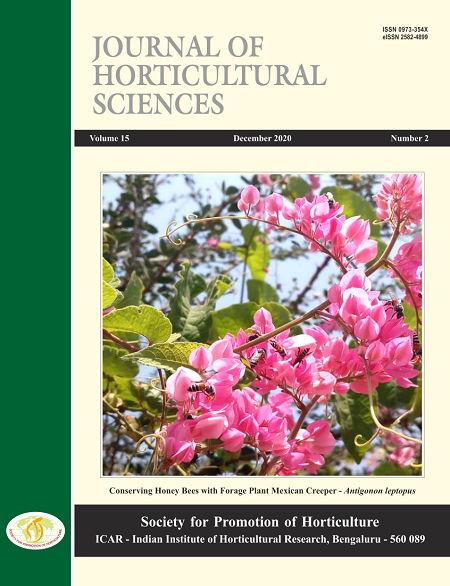Palynological investigations in Jasminum spp.
DOI:
https://doi.org/10.24154/jhs.v15i2.948Keywords:
Jasminum spp., Palynology, Pollen morphology, Pollen germinationAbstract
The present investigation was carried out at the Department of Floriculture and Landscape Architecture, Horticultural College and Research Institute, Tamil Nadu Agricultural University, Coimbatore during 2017-2019. The study involved nine jasmine genotypes, four falling under the commercially cultivated types and five belonging to underutilized species or ‘lesser-known species’. The study was undertaken to investigate and document the palynological parameters of jasmines which could serve as a reliable reference for future jasmine breeding programmes. The palynological investigations were carried out using Scanning Electron Microscopy (SEM), haemocytometry, acetocarmine test, and in vitro pollen germination. The pollen morphology analysis indicated wide variation among the species for the shape of the pollen grain, ranging from tricolpate to prolate; the exine ornamentation was reticulate in all the genotypes. Pollen output was the highest in J. rigidum (28,660 pollen/flower) and the lowest in (625 pollen/ flower) in J. sambac cv. Ramanathapuram Gundumalli. The maximum pollen germination rate and pollen tube length were recorded in J. rigidum.
Downloads
References
Anon, 1974. In: Second Annual Progress Report. Scheme for intensification of research on, the development of rose and jasmine varieties with high essential oil content, ICAR, Tamil Nadu Agricultural University, Coimbatore.
Datta, M. 1960. Cytogenetical Studies on Some Ornamental Jasmines. Caryologia, 13(3): 713-748. DOI: https://doi.org/10.1080/00087114.1960.10797104
Deng, Y. M., X. Q. Ye, X. P. Jia and L. J. Liang. 2014. Pollen germination in vitro and pollen tube growth of Jasminum sambac Aiton. Acta Agri Boreali Sin, 29: 172-178.
Deng Yanming, Xinping Jia, Lijian Liang, Chunsun Gu and Xiaobo Sun. 2016. Morphological anatomy, sporogenesis and gametogenesis in flowering process of jasmine (Jasminum sambac Aiton). Scientia Horticulturae, 198: 257–266. DOI: https://doi.org/10.1016/j.scienta.2015.11.036
Deng, Y., X. Sun, C. Gu, X. Jia, L. Liang and J. Su, (2017). Identification of pre-fertilization reproductive barriers and the underlying cytological mechanism in crosses among three petal-types of Jasminum sambac and their relevance to phylogenetic relationships. PLoS ONE, 12(4), e0176026. DOI: https://doi.org/10.1371/journal.pone.0176026
Domez, E.O., and Isik, S. 2008. Pollen morphology of Turkish Amaryllidaceae, Ixioliriaceae and Iridaceae. Grana 47(1): 15-38. DOI: https://doi.org/10.1080/00173130701860104
Ganga, M., P. Madhumalar, M. Jawaharlal and P. Ranchana. 2015. Assessment of the horticultural significance of lesser known jasmine (Jasminum spp.) wealth. J. Orn. Hort., 18 (1&2): 17-24.
Green, P. and Miller, D. 2009. The genus Jasminum in cultivation. Kew Publishing, Royal Botanic Gardens, Kew.
Hanif, U., Mazhar, M., and Sardar, A.A. 2013. Palyno-morphological studies of some ornamental plants of Mall Road, Lahore. Biologia, 59(1), 147-156.
Makde, K. H. 1982. Tapetal dimorphism in Jasminum grandiflorum Linn. Curr. Sci. 51(3): 661-662.
Raman, V.S. 1955. Cytogenetics of Indian Jasmine, the somatic chromosomes. Cytologia, 20: 19-31. DOI: https://doi.org/10.1508/cytologia.20.19
Rimando, T. J. 2003. Sampaguita production. In: Orn. Hort.: A little giant in the tropics. SEAMEO SEARCA and UPLB, College, Los Banos, Laguna, Philippines, pp: 333.
Sathiyamoorthy, S. 1973. Preliminary investigations on breeding potential of some banana clones. M.Sc. (Hort.) Thesis, submitted to Tamil Nadu Agricultural University, Coimbatore.
Teng, N. J., Y. L.Wang, C. Q. Sun, W. M. Fang and F. D. Chen. 2012. Factors influencing fecundity in experimental crosses of water lotus (Nelumbo nucifera Gaertn.) cultivars. BMC Pl. Biol., 12: 82. DOI: https://doi.org/10.1186/1471-2229-12-82
Velusamy, P. 1981. Genetic studies in Jasminum auriculatum. Vahl. and Jasminum grandiflorum L. Ph.D. Thesis, submitted to Tamil Nadu Agricultural University, Coimbatore.
Wilcock, C and R. Neiland. 2002. Pollination failure in plants: why it happens and when it matters. Trends Pl. Sci., 7: 270–277. DOI: https://doi.org/10.1016/S1360-1385(02)02258-6
Zhao, L. M., H. Sun, M. Huang, S. M. Wang and Y. Q. Wang. 2004. The relationship between seed setting rate and pollen sterility rate for soybean. Soybean Sci., 23: 250–252.
Downloads
Published
Issue
Section
License
Copyright (c) 2020 M Ganga, J Lakshmi, N Manivannan, K Rajamani

This work is licensed under a Creative Commons Attribution-NonCommercial-ShareAlike 4.0 International License.
Authors retain copyright. Articles published are made available as open access articles, distributed under the terms of the Creative Commons Attribution-NonCommercial-ShareAlike 4.0 International License, which permits unrestricted non-commercial use, distribution, and reproduction in any medium, provided the original author and source are credited. 
This journal permits and encourages authors to share their submitted versions (preprints), accepted versions (postprints) and/or published versions (publisher versions) freely under the CC BY-NC-SA 4.0 license while providing bibliographic details that credit, if applicable.





 .
. 











